The first Poreč sea bath
The first sea bath in Poreč was built on the island of Saint Nicholas in 1895 under the name Bagno Parentino. It was also known as Bagno Isola S....
The custom of swimming in the sea is of more recent date, although the healing effect of the sea on the human body has been known since ancient times. In the second half of the 19th century, swimming in the sea was not yet a common habit, especially not among the local population, although bathers in the sea can be seen even in the oldest Istrian vedutas, photographs and postcards. The first arrivals to the sea were related to health tourism due to natural healing factors (sea, sun, air, Mediterranean vegetation...) and the first tourist clientele came from Central Europe. Over time, the northern Adriatic became the main rest and recovery destination of the Austro-Hungarian Monarchy, the natural climate conditions were valorized and some places were declared climatic health spas and seaside resorts. Bathing in the sea began to be given as a "prescription" as one of the methods for treating various diseases and very soon it became extremely popular as a form of entertainment and relaxation too. The culture of swimming in the sea has become since an essential part of the modern man.
The development of the network of baths on the Adriatic coast in the second half of the 19th century and the beginning of the 20th century was influenced by the construction of land and maritime transport infrastructure, but also the popularity of balneology and climatology, sciences that promoted the healing properties and benefits of the natural resources of the sea, sun, air and sand. The real and serious motive for the arrival of tourists in that period were medical and health reasons. One of the important results of these changes is the construction of a, for that time, new tourist infrastructure of sea (city) baths and sunbathing areas.
The planning and construction of bathing buildings in tourist places are closely connected with the development of scientific and medical research that proves the climatic and balneological peculiarities of the climate and place as well as the benefits for their transformation into spas and baths, which over time becomes a generally accepted way of treating certain illnesses and then a new form of rest and recreation.
The bathing architecture was carefully designed to meet the needs of the higher strata Central European clientele. Their construction was mostly made of wood and iron, laid partially or completely above the sea on a stone or concrete base. In accordance with the accepted social code of conduct and moral norms, every bath had its own work as well as bathing regulations displayed in a visible place. Bathers were taken care of at the beach and in the sea, as well as hygiene and cleanliness. Initially, bathing areas had strict rules on separating men and women, which applied to changing rooms and sunbathing areas, while swimming in the sea was often a joint activity or there was a bathing schedule.
In addition to their primary purpose, bathing areas were also places of public social gathering. Various manifestations, social games and sports events were held there, it was a space of freedom and leisure. In the period until the beginning of the Second World War, these secondary functions of the baths were additionally emphasized.
At the beginning of the 20th century, Poreč began to establish itself as a climatic health resort and seaside resort on the Adriatic coast and to develop health tourism. In order for a place to receive the status of a climatic health resort, it was necessary to prove that it has an arranged bathing area, a sufficient number of accommodation and catering facilities for the reception and nutrition of guests and a provided health care. A special obligation of the health resort/bath was the making of a house rule and the price lists of rooms, food and drinks.
In 1908, Poreč was listed in the official Austrian statistics as a tourist destination with 2,590 visitors and thus ranked 46th out of a total of 195 climatic, spa and coastal health resorts in the Austrian part of the Monarchy.
Before the First World War, Poreč with its two arranged sea baths - Bagno S. Nicolò (1895) and Bagno Riviera (1910) - was one of about twenty health resorts and bathing places on the territory of Istria. In advertising leaflets and brochures of that time, Poreč was advertised as a summer and winter resort with a healthy climate and climate identical to that in Nice on the Cote d'Azur. In the summer, it offered swimming, boat trips and fishing, walks along the coast and through pine woods, and in the winter it was recommended as a "health asylum".
In 1912, Poreč had the following accommodation facilities: Hotel Riviera (70 rooms), Hotel Sanremo (24 rooms) and Hotel Alla città di Trieste (20 rooms), and private accommodation began to develop.
During the Italian administration, no new hotel facilities were built in Poreč. Nevertheless, the city still enjoys the title of a famous tourist destination on the Adriatic. After the First World War, travel was democratized and tourist destinations were opened, in addition to elite guests, to other social strata as well. Tourism is taking on a new shape and is becoming more and more summer, bathing and recreational tourism. In addition to bathing, sunbathing is becoming increasingly popular, which is gaining great therapeutic significance (doctors are prescribing so-called sun baths). Recreational sports and entertainment became an imperative of the interwar period.
The beginning of the development of modern tourism in Poreč is considered to be the period of the 1950s when the first catering and tourism companies were founded - Riviera (1953) and Plava laguna (1957), which started with modest accommodation capacities, but with a vision of tourism development as a new socio-economic phenomenon.
The first post-war years were marked by the system of social (workers' and trade union) tourism. With the guaranteed right to paid annual leave and other benefits to domestic workers when going on vacation, the state, in the absence of foreign tourists, tried to encourage the development of domestic tourism. The basis of post-war, mostly domestic tourism, were workers', youth and children's resorts, many of which were in Poreč. Until the mid-1970s resorts were the most visited form of accommodation in Croatia, when they were replaced by hotels.
In their first business plans Riviera and Plava laguna are already turning to mass and foreign tourism, which has been increasingly encouraged by Yugoslav state politics since the early 1960s. The years from 1965 to 1975 were characterized by the most intensive tourist construction, which marked the beginning of the development of modern tourism, thanks to which Poreč successfully entered the international tourist market. Foreign guests are becoming more frequent and more numerous, so overnight stays are starting to count in the millions. Since the 1970s, Poreč has held the title of the metropolis of Croatian and Yugoslav tourism. Tourism is becoming the main economic activity and the sun and the sea, along with the rich cultural and historical heritage, are recognized as the main tourist products on which the current development of Poreč is also based.
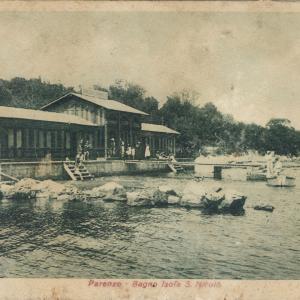
The first sea bath in Poreč was built on the island of Saint Nicholas in 1895 under the name Bagno Parentino. It was also known as Bagno Isola S....
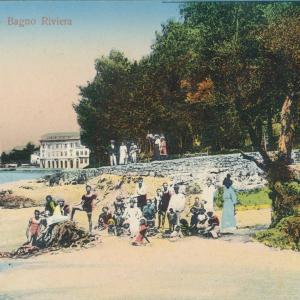
The second Poreč bath called Bagno Riviera (also called San Spirito) was built in 1910 in a bay on the south side of the...
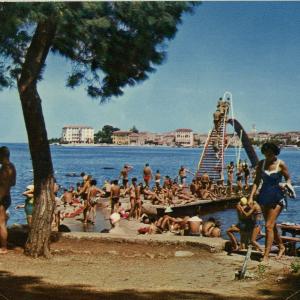
The post-war city bath continues to function on the site of the former Riviera Bath, or Savoia, on its pre-war...
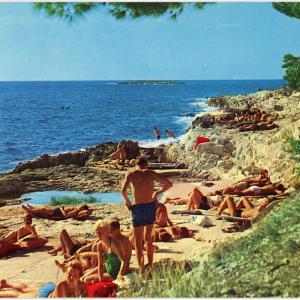
Although the existence of wild and free sea bathing areas was recorded as early as the beginning of the 20th century (Diga and Vallestrin are...
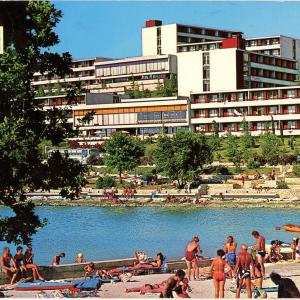
By the end of the 1970s, most beaches in Croatia, including the Poreč area, were arranged, tidy, maintained and full of...
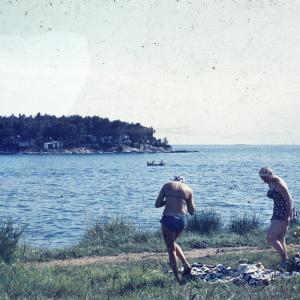
Along with the development of bathing tourism, the history of "official" bathing clothes in public areas - bathing suits -...